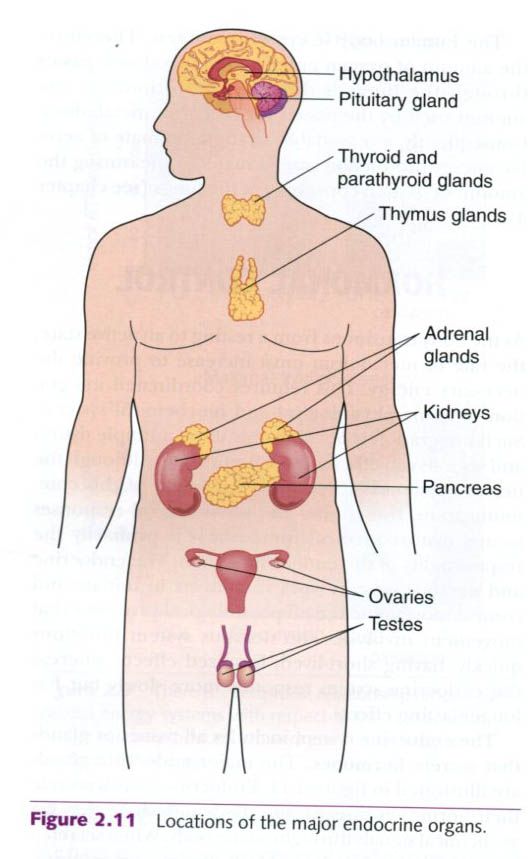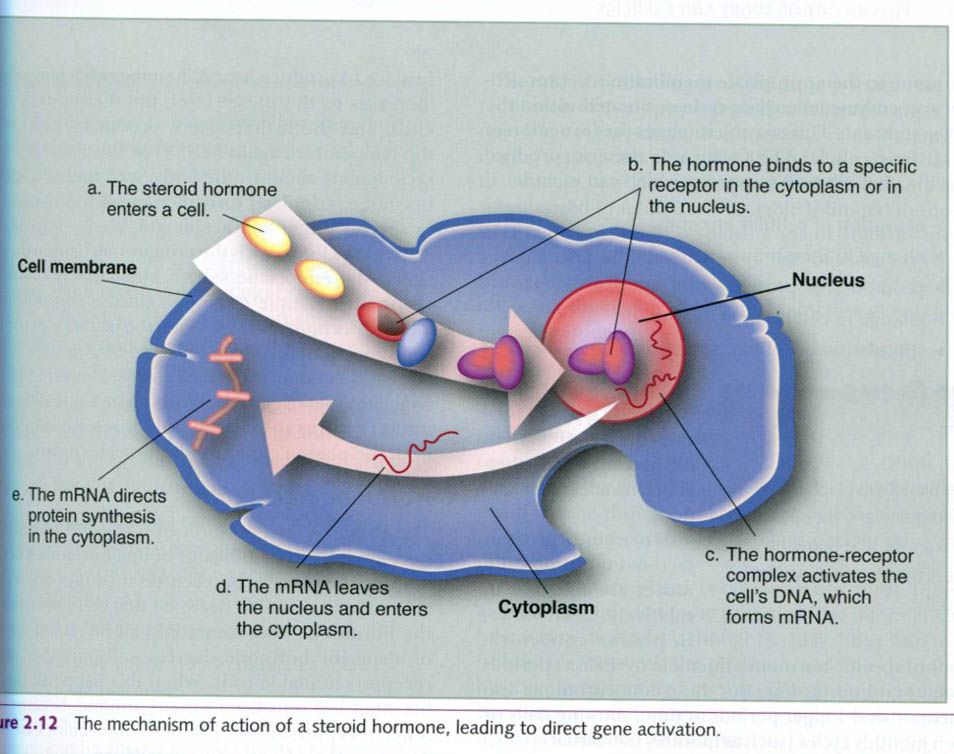Chemical classification of hormones
Hormones can be categorized as two basic types:
steroid hormones and nonsteroid hormones. Steroid
hormones have a chemical structure similar to cholesterol, since most
are derived from cholesterol. For this reason, they are soluble in lipids
and diffuse rather easily through cell membranes. This group includes the
hormones secreted by:
- The adrenal cortex(such as
cortisol and aldosterone);
- The ovaries(estrogen and
progesterone);
- The testes(testosterone),
and
- The placenta(estrogen and
progesterone).
Nonsteroid
hormones are not lipid
soluble, so they cannot easily cross cell membranes. The nonsteroid hormone
group can be subdivided into two groups: protein or peptide chormones and amino
acid-derived hormones. The two hormones from the thyroid gland(thyroxine and
triiodothyronine) and the two from the adrenal medulla(epinephrine and norepinephrine)
are amino acid hormones. All other nonsteroid hormones are protein or
peptide hormones.
Hormone actions
Because hormones travel in the blood, they
contact virtually all body tissues. How, then, do they limit their effects to
specific targets? This ability is attributable to the specific hormone
receptors possessed by the target tissues. The interaction between the hormone
and its specific receptor has been compared with a lock(receptor) and
key(hormone) arrangement, in which only the correct key can unlock a given
action within the cells. The combination of a hormone bound to its receptor is
referred to as a hormone-receptor complex.
Each cell typically has from 2,000 to 10,000
receptors. Receptors for nonsteroid hormones are located on the cell membrane, whereas those for
steroid hormones are found either in the cell’s cytoplasm or in its nucleus. Each
hormone is usually highly specific for a single type of receptor and binds only
with its specific receptors, thus affecting only tissues that contain those
specific receptors. Numerous mechanisms allow hormones to control the actions
of cells.
As mentioned earlier, steroid hormones are
lipid soluble and thus pass easily through the cell membrane. Their mechanism
of action is illustrated below. Once inside the cell, a steroid hormone binds
to its specific receptors. The hormone-receptor complex then enters the
nucleus, binds to part of the cell’s DNA, and activates certain genes. This
process is referred to as direct gene
activation. In response to this activation, mRNA is synthesized within the
nucleus. The mRNA then enters the cytoplasm and promotes protein synthesis. These
proteins may be:
- Enzymes that can have
numerous effects on cellular processes;
- Structural proteins to be
used for tissue growth and repair;
- Regulatory proteins that can
alter enzyme function.
Because nonsteroid hormones cannot cross the
cell membrane, they react with specific receptors outside the cell, on the cell
membrane. A nonsteroid hormone molecule binds to its receptor and triggers a
series of enzymatic reactions that lead to the formation of an intracellular second messenger. A widely distributed
second messenger that mediates a specific hormone-receptor response is cyclic adenosine monophosphate(cyclic AMP,
or cAMP). This mechanism is illustrated in the picture below.
In this case, attachment of the hormone to the
appropriate membrane receptor activates an enzyme, adenylate cyclase, situated
within the cell membrane. This enzyme catalyzes the formation of cAMP from
cellular ATP. Cyclic AMP then can produce specific physiological responses,
which can include:
- Activation of cellular
enzymes
- Change in membrane
permeability
- Change in cellular
metabolism
- Stimulation of cellular
secretions.
Thus, nonsteroid hormones typically activate
the cAMP system of the cell, which then alters intracellular functions.
Hormones are not secreted uniformly, but rather
are released in relatively brief bursts, so plasma concentrations of specific
hormones fluctuate over short periods such as an hour or less. But these
concentrations also fluctuate over longer periods of time, showing daily or
even monthly cycles(such as monthly menstrual cycles). How do endocrine glands
know when to release their hormones?
Most hormone secretion is regulated by a negative feedback system. Secretion
of a hormone causes some change in the body, and this change in turn inhibits
further hormone secretion. Consider how a home thermostat works. When the room
temperature decreases below some preset level, the thermostat signals the
furnace to produce heat. When the room temperature increases to the preset
level, the thermostat’s signal ends, and the furnace stops producing heat. When
the temperature again falls below the preset level, the cycle begins anew. In the
body, secretion of a specific hormone is similary turned on or off(or up or
down) by specific physiological changes.
Negative feedback is the primary mechanism
through which the endocrine system maintains homeostasis. Using the example of
plasma glucose concentrations and the hormone insulin, when the plasma glucose
concentration is high, the pancrease releases insulin. Insulin increases
cellular uptake of glucose, lowering plasma concentration of glucose. When
plasma glucose concentration returns to normal, insulin release is inhibited
until the plasma glucose level increases again.
Hormone receptors
The plasma concentration of a specific hormone
is not always the best indicator of that hormone’s activity because the number
of receptors on target cells can be altered to increase or decrease that cell’s
sensitivity to the hormone. Most commonly, an increased amount of a specific
hormone decreases the number of cell receptors available to it. When this
happens, the cell becomes less sensitive to that hormone, because with fewer
receptors, fewer hormone molecules can bind. This is reffered to as downregulation, or desensitization. In
some people with obesity, for example, the number of insulin receptors on their
cells appears to be reduced. Their bodies respond by increasing insulin
secretion from the pancreas, so their plasma insulin concentrations increase.
To obtain the same degree of plasma glucose control as normal, healthy people,
these individuals must release much more insulin.
In a few instances, a cell may respond to
the prolonged presence of large amounts of a hormone by increasing its number
of available receptors. When this happens, the cell becomes more sensitive to
that hormone because more can be bound at one time. This is reffered to as upregulation. In addition, one hormone
occasionally can regulate the receptors for another hormone.
Prostaglandins
Prostaglandins, although technically not hormones, are often
considered to be a third class of
hormones. These substances are derived from a fatty acid, arachidonic acid, and
they are associated with the plasma membranes of almost all body cells.
Prostaglandins typically act as local hormones, exerting their effects in the
immediate area where they are produced. But some also survive long enough to
circulate through the blood to affect distant tissues. Prostaglandin release
can be triggered by many stimuli, such as other hormones or a local injury.
Their functions are quite numerous because there are several different types of
prostaglandins. They often mediate the effects of other hormones. They are also
known to act directly on blood vessels, increasing vascular permeability(which
promotes swelling) and vasodilatation. In this capacity, they are important
mediators of the inflammatory response. They also sensitize the nerve endings
of pain fibers; thus, they promote both inflammation and pain.
“Physiology of sport and exercise”, fourth
edition; Jack H. Wilmore, David L. Costill, W. Larry Kenney












0 коментара:
Постави коментар